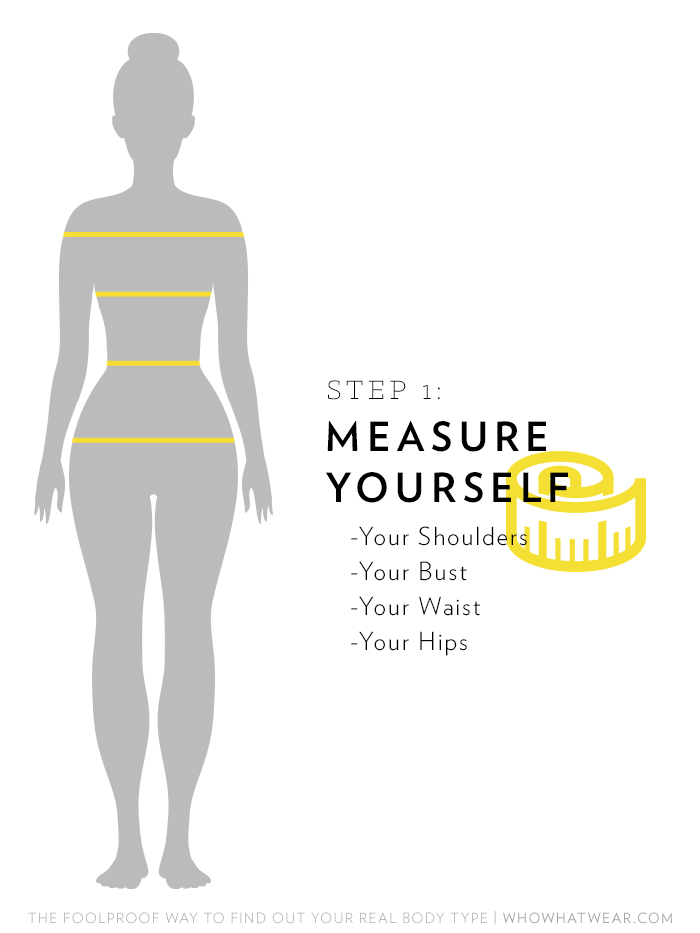Until we discovered the body shape calculator, we didn’t have a fail-safe way of being able to find out what clothes suit our personal silhouettes. And thanks to our brilliant co-founder Hillary Kerr, we know that not every trend is for everyone, and that’s okay. Instead of panicking and buying in on every fashion trend, and dressing for your particular shape, rather than working against it, the body shape calculator will ensure you’re more comfortable and confident.
So how do we use it? Rather than comparing yourself to pictures of celebrities or fruit, which can leave you feeling unsure if you’ve arrived at the right conclusion, we’re using Oprah’s fashion expert Bradley Bayou’s foolproof technique. Bayou’s system uses maths—it is a little intensive, but we’ll walk you through it—to double-check that you’ve found your real figure.
We’re limiting this article to four common types for simplicity’s sake, but for a more in-depth look at every shape and size, check out Bayou’s The Science of Sexy, where he gives tips on how to dress 48 different figures. Also, keep in mind that no matter what your size is, you can have any of the below four outlines; it’s more about how your weight (whatever it may be) is distributed.
With that said, get out your tape measure and scroll down for the brilliant body shape calculator.










Shoulders: Have someone help you measure from the tip of one shoulder all the way around you. The measuring tape should be high up around your shoulders so it almost slips off.
Bust: Pull the measuring tape taut across the fullest part of your bust and around your back. Don’t pull the tape so taut that your breasts start to get squashed.
Waist: Measure the smallest part of your natural waist, just above the belly button.
Hips: Start at one hip (below the hip bone) and wrap the tape measure around the largest part of your butt.
Now that you have your measurements, you’ll use those numbers to calculate your body shape. You’ll notice the equations below allow you to use your bust or shoulder measurements interchangeably. Doing this accounts for those who have especially big or small busts or especially narrow or broad shoulders.
You may find that doing the equation with your shoulders versus your bust places you in two different body type categories. This means your body type may actually encompass more than one category; for example, you may find you’re more of a pear when using your bust measurement and more of an hourglass when using your shoulder measurement. If this is the case for you, you should consider both body types when shopping, and ultimately make purchases by seeing what looks best on you.
Scroll down to see which shape description matches your body the best, and then use Bayou’s equation to validate that you’ve found your true shape.
Confirm by checking the numbers! You are an inverted triangle if your shoulder or bust measurement is more than 5% bigger than your hip measurement (shoulders or bust ÷ hips ≥ 1.05). For example, you are an inverted triangle if your shoulders are 36 inches and your hips are 34.25 inches or smaller.
Confirm by checking the numbers! You are a rectangle if your waist is less than 25% smaller than your shoulder or bust (waist ÷ shoulders or bust ≥ .75) AND your shoulder, bust and hip measurements are within 5% of each other. Find this out by looking at your shoulder, bust and hip measurements. Call the largest of the three measurements t (it will usually be your shoulders) and the other two measurements y and z. Multiply t by 0.95. If y and z are greater than the result of t x 0.95, then your shoulder, bust and hips are within 5% of each other.
For example, you are a rectangle if your shoulders are 36 inches and your waist is 27 inches or more.
Confirm by checking the numbers! You are a triangle (also known as a pear) if your hips are more than 5% bigger than your shoulders or bust (hips ÷ shoulders or bust ≥ 1.05).
For example, you are a triangle if your shoulders are 36 inches and your hips are 37.75 inches or larger.
Confirm by checking the numbers! You are an hourglass if your waist is at least 25% smaller than your shoulder or bust (waist ÷ shoulders and bust ≤ 0.75) AND your waist is at least 25% smaller than your hips (waist ÷ hips ≤ 0.75) AND your shoulder and hip measurements are within 5% of each other.
Find this out by looking at your hips and shoulder measurements. Call the larger of the two measurements t and the smaller of the two measurements y. Multiply t by 0.95. If y is greater than the result of t x 0.95, then your hips and shoulders are within 5% of each other.
For example, you are an hourglass if your shoulders and hips measure 36 inches and your waist is 27 inches or smaller.
Want more? Check out the complete guide to dressing for your body shape.
This piece was published at an earlier date on Who What Wear US and has since been updated.





Leave a Reply